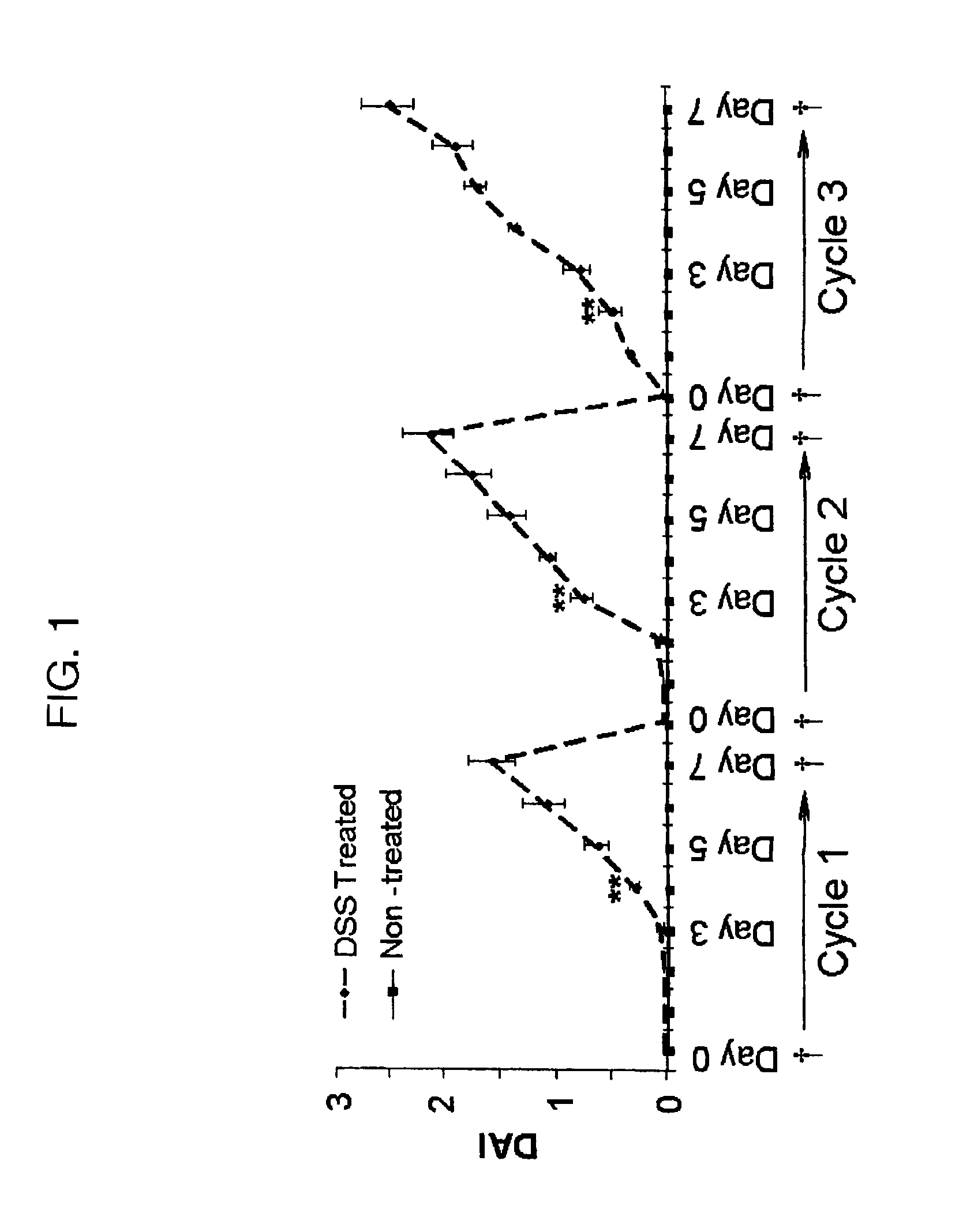Genotoxicity as a biomarker for inflammation
a biomarker and genotoxicity technology, applied in the field of systemic genotoxicity as a marker for inflammation, can solve the problems of low diagnostic accuracy of crp, hinder the accuracy of inflammatory activity, etc., and achieve the effect of effective reducing the amount of markers present, and monitoring the efficacy of treatment of inflammatory diseas
- Summary
- Abstract
- Description
- Claims
- Application Information
AI Technical Summary
Benefits of technology
Problems solved by technology
Method used
Image
Examples
example 1
Intestinal Mucosal Inflammation Leads to Systemic Genotoxicity in Mice
[0048]This example demonstrates that genotoxicity is elicited systemically by acute and chronic intestinal inflammation. In this study, genotoxic endpoints were assessed in peripheral leukocytes (DNA single and double strand breaks and oxidative DNA damage) and normochromatic erythrocytes (micronuclei) during chemical or immune-mediated colitis. During three consecutive cycles of intestinal inflammation induced by dextran sulfate sodium (DSS) administration, genotoxicity to peripheral leukocytes and erythroblasts was detected in both acute and chronic phases of DSS-induced inflammation. Reactive oxygen species mediated oxidative stress and DNA damage was confirmed with positive 8-oxoguanine and nitrotyrosine staining in peripheral leukocytes. Levels of DNA damage generally decreased during remission and increased during treatment, correlating with clinical symptoms and systemic inflammatory cytokine levels. In Gαi...
example 2
Elevated DNA Damage and Persistent Immune Activation in Atm Deficient Mice with Dextran Sulfate Sodium-Induced Colitis
[0132]This example describes the systemic DNA damage and immune response to induced experimental colitis in mice deficient in ATM, a DNA double-strand break recognition and response protein. To determine the effect of Atm deficiency in inflammation, we induced experimental colitis in Atm− / −, Atm+ / − and wildtype mice via dextran sulfate sodium (DSS) administration. Atm mice had higher disease activity indices and rates of mortality compared to heterozygous and wildtype mice. Systemic DNA damage and the immune response were characterized in peripheral blood throughout and after three cycles of treatment. Atm− / − mice demonstrated increased sensitivity to levels of DNA strand breaks in peripheral leukocytes, as well as micronuclei formation in erythroblasts compared to heterozygous and wildtype mice, especially during remission periods and after the end of treatment. Mar...
example 3
Additional Data on Characterization of Systemic Genotoxicity and the Potential Mechanisms Involved
[0219]In an effort to further characterize susceptible cell types to DNA damage, subpopulations of leukocytes in the peripheral blood as well as cells from distant lymphoid and non-lymphoid tissues were analyzed for DNA single- and double-stranded breaks. We also hypothesized that mediators of inflammation such as tumor necrosis factor-alpha (TNF-α) would be sufficient and necessary to induce the observed systemic genotoxicity in mice without preexisting inflammation. DNA damage was found in both lymphoid and non-lymphoid cell types, manifesting more damage to CD4 and CD8 T-cells versus other cell types. TNF-α was sufficient to induce systemic genotoxicity in wildtype mice. Examination of transcript levels as well as protein expression levels of the DNA double strand break recognition and repair protein ataxia telangiectasia mutated (ATM) in CD4 and CD8 T-cells revealed no differences i...
PUM
| Property | Measurement | Unit |
|---|---|---|
| pH | aaaaa | aaaaa |
| pH | aaaaa | aaaaa |
| half life | aaaaa | aaaaa |
Abstract
Description
Claims
Application Information
 Login to View More
Login to View More - R&D
- Intellectual Property
- Life Sciences
- Materials
- Tech Scout
- Unparalleled Data Quality
- Higher Quality Content
- 60% Fewer Hallucinations
Browse by: Latest US Patents, China's latest patents, Technical Efficacy Thesaurus, Application Domain, Technology Topic, Popular Technical Reports.
© 2025 PatSnap. All rights reserved.Legal|Privacy policy|Modern Slavery Act Transparency Statement|Sitemap|About US| Contact US: help@patsnap.com



